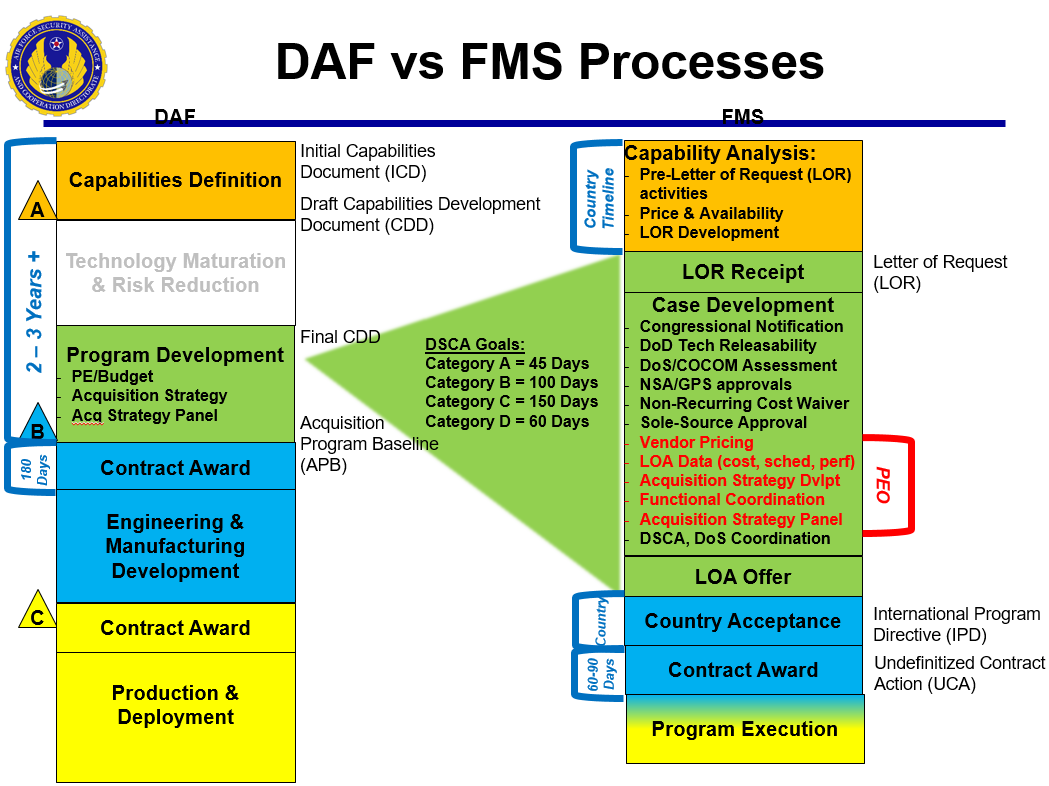WRIGHT-PATTERSON AIR FORCE BASE, Ohio (AFLCMC) -- In Foreign Military Sales (FMS), people notice when a United States Air Force (USAF) aircraft, missile, or other significant weapon system gets delivered to a partner nation. What people don’t typically see is all of the behind-the-scenes work done by the Air Force Security Assistance and Cooperation Directorate (AFSAC) within the Air Force Life Cycle Management Center, to develop an FMS case.
Case Managers, Command Country Managers, Case Support Managers, Logisticians, and other experts at AFSAC interface directly with foreign nationals representing 116 Partner Nations and eight NATO organizations on a daily basis. Together, AFSAC and partner nations collaborate to identify the military requirements of the partner nation that address the partners’ national security concerns and supports the U.S. National Defense Strategy (NDS).
How USAF FMS Case Development Works
The following AFSAC chart provides a brief overview of the FMS case development process for a U.S. partner nation. It also compares the acquisition process for the Department of the Air Force (DAF) on the left to the acquisition of USAF capabilities by a foreign partner via FMS on the right.
The green portion of the FMS timeline is the FMS case development phase. It’s the “bread and butter” of AFSAC.

When authorized personnel of the U.S. Government (USG) receive a complete and actionable Letter of Request (LOR) from an authorized representative of a Partner Nation, that step is called “LOR Receipt.” That’s when AFSAC begins the FMS case development process with a country.
“AFSAC interfaces with the country’s representatives to clearly understand requirements and serves as an ‘integrator’ of all USG agencies involved in developing an FMS case,” explained Ron Taylor, AFSAC Deputy Director. Here’s a brief overview of what the ‘integrator’ role performs:
- Congressional Notification: If a request meets certain dollar and scope thresholds, then AFSAC will notify the U.S. Congress to approve or disapprove the request as a potential sale.
- U.S. Department of Defense (DOD) Tech Releasability: AFSAC interfaces with the DOD to confirm if the capability being requested is authorized for release to foreign partners.
- U.S. Department of State (DOS) Combatant Command (COCOM) Assessment: AFSAC interfaces with the DOS to confirm if the requesting country is approved to participate in USG FMS.
- USAF Program Offices (POs): AFSAC interfaces with the POs to gather all of the technical capability data needed to draft a formal Letter of Offer and Acceptance (LOA) to a Partner Nation.
Once an LOA is developed, AFSAC offers it to the country. This step is known as “LOA Offered” and completes the FMS case development process. It’s important to note that an LOA can cover a completely new capability, or it can cover an amendment or modification to an existing capability.
$24B in Total LOAs Offered to Partner Nations at FY21 Midpoint
The end of March 2021 marked the half way point for the Fiscal Year 2021 (FY21) reporting of Foreign Military Sales (FMS), and AFSAC FMS case development teams accomplished a lot.
In the first 6 months of FY21, AFSAC offered $24.5 billion in LOAs, supporting both new LOAs and amendments/modifications to existing LOAs for FMS Partner Nations. The $24.5 billion in “offered” FMS cases nearly equals total AFSAC sales for all of FY2020 ($24.8billion).
“I did not fully appreciate the complexity of AFSAC’s contribution to our national defense until I had the chance to be part of this team,” said Brig. Gen. Brian Bruckbauer, reflecting on his time at AFSAC. “I’m honored to have the opportunity to work at AFSAC and see firsthand all of the amazing work this team accomplishes supporting the U.S. National Defense Strategy priority of strengthen relationships with international partners and allies.”
It’s worth noting that AFSAC professionals performed this significant case development workload during the COVID pandemic. It’s a testament to the “can-do” attitude of the AFSAC team. AFSAC showed tremendous resiliency to adapt, grow, and advance its mission to, “Deliver airpower capabilities that strengthen international partnerships and advance military interoperability.”
For more information about AFSAC, you can visit the following websites here:
You can also email the AFSAC workflow at aflcmc.wf.workflow@us.af.mil with any questions you have regarding USAF FMS.